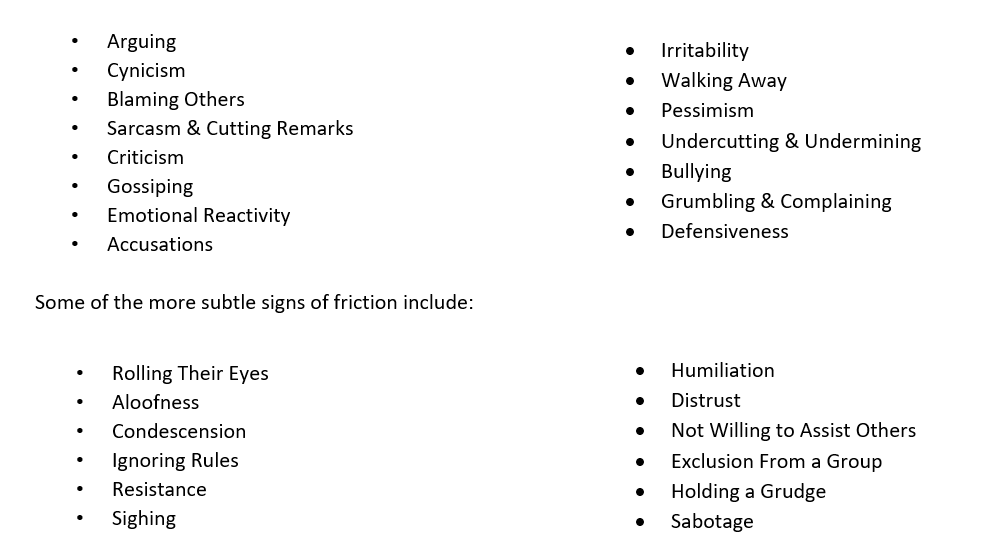The Different Faces of Workplace Conflict
Not all conflicts look the same. And sometimes we don’t even realize there is tension in the air until someone points it out to us (“Have you noticed how standoffish Julie has been to us since that disagreement in the last team meeting?”). On the other hand, some individuals perceive friction when it doesn’t really exist in the other person’s mind. For example, you may think someone is upset with you because they have been “cool” toward you, when, in actuality, they are not very interactive because they are concerned about their mother who is in the hospital.
Let’s lay out some of the common ways conflict is demonstrated in the workplace – some behaviors make the discord obvious to anyone in the room, while others are more subtle.
You might be saying to yourself, “So what? Nothing new here.” But I would encourage you to take a moment to go back through the lists, reflect and ask yourself, “Which of these do I see in my workplace?” And, “Which of these do I either experience from others or demonstrate occasionally?”
WHAT TO DO FIRST: KEEP THINGS FROM BLOWING UP
Although we don’t like it, most of us are okay with a little disagreement at work occasionally. It happens, right? But what we really don’t like is the anxiety that starts to increase when we (and others) are concerned that the tension is growing – and we don’t know when it will end and where it will lead. You may start to hear suggestions like, “Just let it go, Carol. It’s not that big of a deal.” Or someone may ask, “Do you think I should say something? Did you see the look on her face? It was like she was shooting daggers from her eyes!”
The concern becomes not the interaction that occurred or even how people are feeling now, but what needs to happen to keep this from blowing up into a major conflict?
Here are a few potential actions to take (followed by a few things not to do):
- Stop and reflect (don’t immediately react). If you are upset about a situation, slow down and take a few deep breaths. Ask yourself: Am I sure I heard what was said correctly? Is it possible I missed something? Is there someone I could ask for clarification or confirmation?
- Seek clarification and understanding – either from a colleague who was also present or from the person who communicated the message. Be careful how you phrase your questions. Don’t start with: “Are you kidding me? Did you really say …?” or “Did I mishear you or are you actually an idiot?” Try an introduction like: “Brian, I’m confused. Could you help me out?” Or, “I’m struggling with what just happened. I’m wondering if I misheard or misinterpreted what was communicated. Can you help me understand?”
- Only get involved in trying to resolve a tense situation if that is your role. Generally, in relationships, if there is a conflict or misunderstanding, the individuals in the misunderstanding are the only individuals who need to be working to resolve the miscommunication. Unless you are a kindergarten teacher, it is best not to get in the middle and help Crystal and Naomi work out their differences. At work, however, there are situations where a supervisor may assist in helping smooth the waters between two of their team members, but these are infrequent.
Now that you have slowed down your reaction to a situation, here are a couple of additional things to do:
- Listen. If you were present when the incident occurred, you can act as a sounding board for clarification or confirmation – if asked.
- If you were not directly involved in, or present when the conflict took place, don’t serve as the go between.
- Keep your mouth shut and your thoughts to yourself. There is very little good that comes from talking to someone else (who also isn’t part of the conflict) about the situation. That is called gossip.
If you are directly involved in a conflict with a coworker, one of the most important steps is to assess the source or reason for the conflict (which is addressed in Chapter 3 of Making Things Right at Work – “Where It Starts”). Only then will you be able to develop an appropriate plan for moving forward.
* * * * * * *
NOTE: This blog is part of a series introducing some of the topics and tools we cover in Making Things Right at Work. In the coming weeks, we will be offering three $50 gift cards to individuals who: a) purchase the book, b) take a photo of themselves with the book, c) post the photo on either LinkedIn, Facebook or Instagram with the hashtag #MakingThingsRight, and d) notify us at drpaul@appreciation.com of their post. We will draw one gift card each week for those who posted the prior week.
Categories 5 Languages of Appreciation, Making Things Right at Work, Toxic workplaces
JOIN OUR NEWSLETTER
Enter your email to receive a free excerpt from The 5 Languages of Appreciation and tips on how to improve appreciation in your workplace.
Sign Up Now

